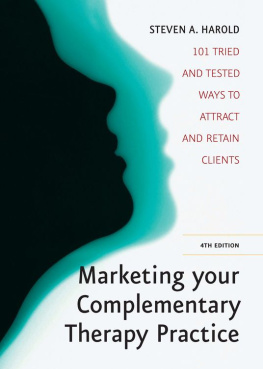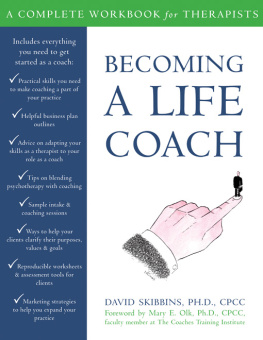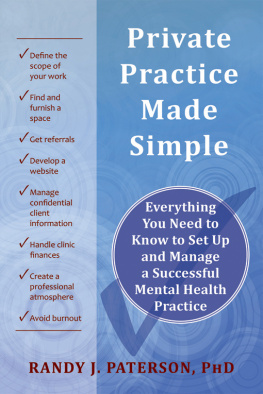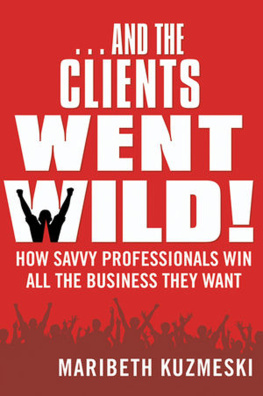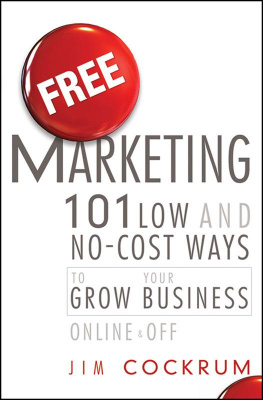I would like to thank the many people who have played a part in bringing this book into existence. To Terence Watts for being my unofficial mentor in my early days of practice; Nicola Martin of the Institute of Clinical Hypnosis for providing the opportunity to change my dreams into reality; Pauline and Dennis Yates for being my editors; my parents Raymond and Mavourneen for always being there. Lastly, my special thanks must go to John for his encouragement, support and belief in me.
Today there are hundreds of alternative and complementary therapies available to the general public as well as the more conventional therapies of psychotherapy or counselling. The vast majority of these therapies are not available through your doctor. They have to be sought out. To benefit from these therapies the public has to find therapists who are in private practice.
As well as the existence of many different types of therapy, there are also hundreds of schools offering training on how to become a therapist in any chosen subject from acupuncture to reiki, from kinesiology to naturopathy there are many options with which to make your trade in the alternative and conventional medicine arena. You can take a correspondence course, a course over a period of years or an intensive course over a period of days and at the end call yourself a therapist. A course should not be judged by the period of time involved. Some of the best and most skilful therapists are self-taught and have never seen the inside of a classroom since leaving school.
Whichever way you become competent in your skill, you will have one major lesson to learn when you graduate: how to attract clients to your practice. Some schools do an excellent job of providing their graduates with the necessary business skills to enable them to taste success quickly. Others do not provide an adequate grounding or the type of continued support necessary to help a fledgling therapist move from seeing an occasional client to having a full-time practice. Many therapy graduates have expectations of becoming a full-time therapist. They may see an opportunity of moving from a career that bores them to something more exciting. Without appropriate marketing skills, they are likely to fail and will probably return to their old career or at best have a very part-time business in which they occasionally attract a client or two.
You should not jump from a full-time career to self-employment in one leap unless you have a safety net in place! The safety net could be a redundancy lump sum, a supportive partner or other funding to help you while you get your practice up and running. If you dont have any of these then you should consider reducing your hours in the old profession as you increase the hours in the new career. You could negotiate a reduction in the hours with your current employer such as moving from a five-day week to four days. As your therapy practice expands over a period of time, you can reduce the hours you spend in the old career, eventually making a complete career change. This approach brings the comfort of knowing you have another source of income and takes away some of the financial pressure from your therapy practice.
Being a successful therapist, particularly in private practice, requires good marketing skills. It is no good being the most effective therapist in the world if you dont tell the world that you exist. Your practice will be a success or failure depending on your therapy and marketing skills. Most therapists have to find out the hard way what works for them and what doesnt.
Some new therapists fall into the trap of attempting to buy their clients, in effect throwing away their hard-earned funds (usually saved from their previous career) into advertising. Any form of promotion should be researched and approached in the same manner you would use with your therapy clients.
Advertising is not marketing but is just one part of the process. Marketing involves the four Ps: Product (or service), Promotion, Price and Place. Each has an important role to play. Get any one of them wrong and you will lose business. To the four Ps we should add a fifth P: Persistence. Persistence pays dividends.
The purpose of this book is to give you so many ways of marketing your practice that it will be virtually impossible to fail. Yet, even armed with this book some will still not see the light. A history teacher whose students were worried about a forthcoming exam was heard to say that even if she gave them all the questions, there would be some students who would still fail. Her message was simple: having the information to succeed is one thing, using it is another. If you want to succeed you need to take action again and again.
If you use this book as it is intended to be used you should be able to create a tidal wave of enquiries from potential clients. Take the ideas detailed here and not only use them as they stand but also adapt them to your circumstances. When you have undertaken all the marketing methods in this book you will be ready to start from the beginning again. There are many more than 101 ways to market your practice. You will know that you are successful when you start to create your own ideas.
Look at it this way: if you just manage to attract one extra client through reading this book, it will have paid for itself. In reality this book has the potential to pay for itself over and over again.
Before you get into the contents of this practical book on marketing, it is important to know about an aspect of marketing that will make or break your efforts.
All the tips in this book are very practical. The books aim is to offer such a broad spectrum of ideas that any therapist who is based in or near any reasonably-sized town or city, should never be short of ideas on how to market their practice.
Yet some therapists, despite having these 101 client-attracting ideas, will still not enjoy enough business to survive financially as a therapist. Even if this book had 1001 ideas some therapists would still struggle to get enough fee-paying clients each and every week. There is a very good reason for this as you will soon discover.
The purpose of this chapter is to explain for example why a therapist in Leeds will fail and yet another therapist offering the same therapy and who is also based in Leeds will succeed.
Believe it or not, the difference between those two therapists will not be that one has a bigger marketing budget or is a more skilled therapist than the other, although these factors do make a difference of course. But that is not the reason for the difference in the success of their individual practices in this example.

